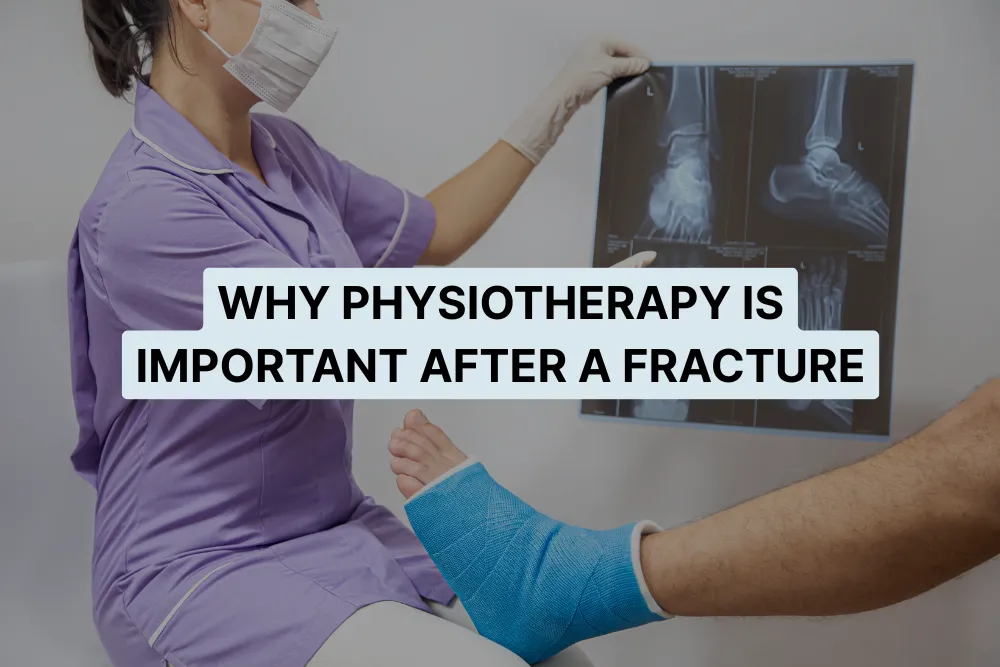Fracture recovery and physiotherapy go hand in hand. When a bone breaks, most people focus on the cast, the X-rays, and the countdown to the day it comes off. But here’s the truth: the real recovery begins after the cast is removed.
Weeks of immobilization leave the body in a vulnerable state. The bone may have healed, but the surrounding muscles, joints, and tissues are far from normal. Without proper rehabilitation, you risk stiffness, weakness, and even long-term complications.
This is where physiotherapy can help. Here’s how it makes a difference after a fracture:
1. Restores Movement and Flexibility
After weeks in a cast, joints feel locked, tight, and resistant. Physiotherapy uses guided mobilization and stretching techniques to safely restore the natural range of motion. This prevents lasting stiffness and helps you move freely again.
2. Rebuilds Lost Strength
Muscles can lose up to 30–40% of their strength during immobilization. Targeted strengthening exercises are required to be done, starting gently and progressing gradually so you regain muscle power without risking another injury.
3. Controls Pain and Swelling
Lingering pain and swelling aren’t just inconvenient, they slow down healing. Manual therapy, movement-based rehab, and modalities like ultrasound or cold therapy helps reduce discomfort and speeds up tissue recovery.
4. Brings You Back to Daily Life Faster
Whether it’s climbing stairs, lifting groceries, or writing with your hand again, rehab shortens the gap between “cast off” and “life as usual.” Patients who commit to proper rehab often regain independence weeks earlier than those who don’t.
5. Prevents Long-Term Problems
Skipping rehab may feel tempting, but it comes with risks: joint stiffness, chronic weakness, or even early arthritis. Physiotherapy ensures your bones, muscles, and joints heal in harmony reducing the chance of future complications.
What Does Physiotherapy After a Fracture Involve?
Physiotherapy isn’t just a set of random exercises. It’s a structured journey designed around your healing stage and daily needs. Here’s what that usually looks like:
Early Phase (right after the cast comes off)
At this stage, your therapist focuses on gentle movement and pain relief. You’ll start with simple guided exercises to ease stiffness, reduce swelling, and reintroduce motion into the joint. Techniques like stretching, cold therapy, or manual therapy help you move better.
Middle Phase (building strength and confidence)
Once mobility improves, the focus shifts to rebuilding muscle strength. Expect carefully graded exercises starting light and gradually progressing. If your fracture involves the leg or foot, you’ll also work on gait training to restore balance and walk without limping.
Later Phase (returning to full independence)
As strength returns, rehab moves toward restoring function. This might include lifting, climbing stairs, or other activities that matter to your daily life. If surgery was involved, scar and soft tissue care may also be part of the plan. You’ll likely receive a home exercise program to keep progress going between sessions.
Final Phase (prevention and long-term recovery)
Physiotherapy doesn’t just stop when you feel “better.” The last step ensures your muscles, joints, and bones are working in harmony, reducing the risk of future stiffness, weakness, or arthritis. By this stage, you’re not only recovered, you’re stronger and more confident than before.
The Bottom Line
A fracture heals in weeks. But without physiotherapy, recovery can take months or leave you with permanent limitations.
It helps you move freely again, regain strength, ease pain and swelling, get back to daily activities faster, and avoid long-term problems. Rehab starts gently, then builds strength and function, making sure your body heals fully and stays strong.
References:
- Handoll HH et al., Cochrane Database Syst Rev. 2015.
- Wall BT et al., J Appl Physiol. 2013.
- Brudvik C, Physiotherapy. 2011.
- Lamb SE et al., BMJ. 2007;335:839.
- JOSPT. 2016;46(2):83-90.

Amit Saraswat is the Founder of Physioveda Medical Center, a Dubai-based clinic focused on personalized physiotherapy and integrative healthcare. With a passion for patient-centric solutions, he leads the vision behind Physioveda’s evidence-based approach to pain relief and long-term recovery.

